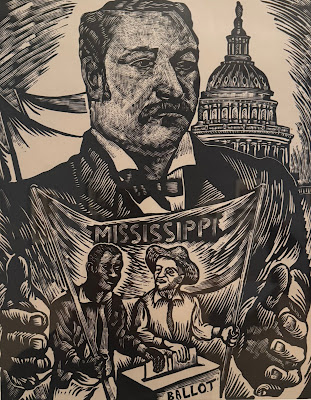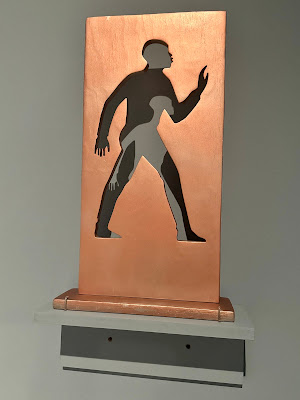Born to freed slaves in Washington, DC,
Elizabeth Catlett lived nearly a century, long enough to see Barrack Obama elected president. In between, her skin color prevented her from attending
Carnegie Institute of Technology--Andy Warhol's alma mater--and the United States banned her from returning to America after she moved to Mexico because of her association with an artists collective, some of whose members belonged to the Communist Party. A survey of Catlett's work at the Brooklyn Museum is truly revelatory; the artist looks at racism and sexism with the clear-eyed gaze evident in an early sculpture.
 |
| "Young Girl" (1946) |
As far as I'm concerned, her "Black Woman" series of woodcuts (1946-47) ranks with some of the best art ever printed in America.
 |
| "I have special reservations" |
 |
| "In Phillis Wheatley | Proved Intellectual Equality in the Midst of Slavery" |
 |
| "I Have Always Worked Hard in America" |
Firing on all cylinders, Catlett offered a powerful visual analog to
the incipient Civil Rights movement.
 |
"Civil Rights Congress" (1949)
|
She sees dignity in individuals, not their professions.
 |
| "Sharecropper (Male)" (1945) |
 |
| "Sharecropper" (1952) |
Though dramatic and compelling, his work lacks her powerful simplicity.
 |
| "(Indigenous People of Mexico are Stripped of Their Land)" by Francisco Mora (1947) |
Catlett, determined to highlight acts of African-American heroism even as an expatriate, led an ill-fated group project during the mid 50s called "Against Discrimination in the United States."
Taller de Gráfica Popular planned to publish the series in
Freedom, a Black newspaper in America founded by
Paul Robeson. But when the publication refused to accept one of the prints (the museum doesn't indicate which one), the collective withdrew the entire series from consideration. Could lionizing
Nat Turner have been a step too far?
The US government, then routinely surveilling artists for their political activities, forced Catlett (who was arrested in Mexico City for her involvement in a railroad strike) to view the
Black Power movement from afar. She had renounced her citizenship after it barred her from re-entering the country, even to visit her dying mother.
 |
| "Malcolm X Speaks for Us" (1969) |
However, after
Eldridge Cleaver (
lower panel, left) revealed his misogyny in
Soul On Ice, she deleted his image from future editions of this linocut, sacrificing aesthetic balance for her deeply feminist convictions. The memoir may have been sexist, but reading it helped
my father become more progressive in his views on race.
 |
| "Homage to the Panthers" (1970) |
Catlett ardently supported the release of
Angela Davis, an intellectual and charismatic activist who had been arrested by the FBI. A jury acquitted the philosophy professor at UCLA who earlier had been fired for her "real" crime, membership in the Communist party.
 |
| "Free Angela" (1972) |
It's hard to argue against this symbolism of this work half a century after Catlett sculpted it.
 |
| "Target Practice" (1970) |
Mora depicted his revolutionary wife at work in this undated sketch. Catlett advised other women: Marry a feminist. My husband defends the rights of women whenever he sees them infringed upon. He specifically defends my right to work as an artist and have a career.
They had three children, all of whom pursued careers in the creative arts.
 |
| "My Children" (1958) |
 |
| "Floating Family" by Elizabeth Catlett (1995-96) |
Has equality ever been more beautifully expressed?
 |
"Freedom" (1998)
|
Catlett regained her US citizenship after Mora died in 2002, although she continued to live in Mexico for the remainder of her life. She never stopped working--or appreciating Black contributions to American culture.
 |
| "Gossip" (2005) |
























No comments:
Post a Comment